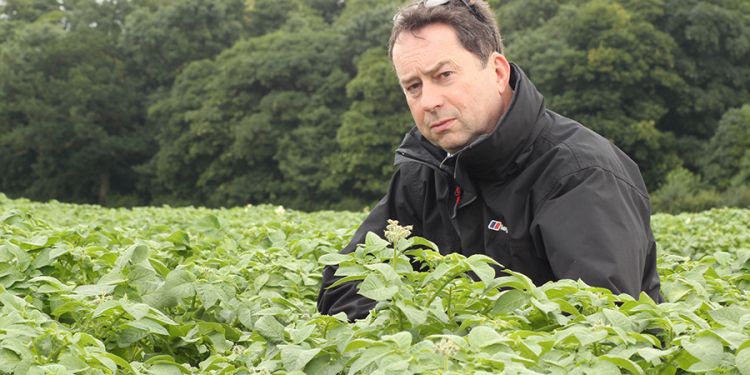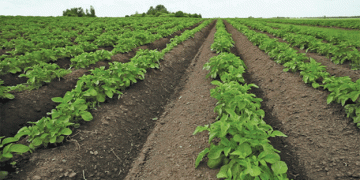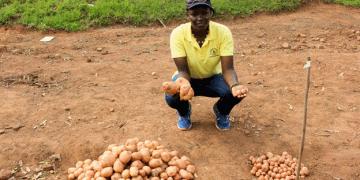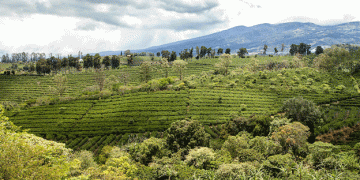Planting a potato cyst nematode (PCN) trap crop can naturally reduce nematode numbers by up to 75%. One group of potato farmers have trialled whether they can be successfully established in the UK.
As chemical methods that once effectively controlled the pest are dwindling – the latest loss being the mainstay nematicide Vydate – growers are now looking at alternative biological control techniques. Effective trap crop establishment could hold the key to a significant drop in PCN numbers and costing around 45% less than the use of a nematicide at £550/ha, the economics add up for potato farmers.
What are trap crops?
Trap crops aim to reduce overall nematode PCN population numbers by deceiving nematodes into hatching by the release of chemicals from their roots, explains independent research agronomist Ivan Grove, who worked on the trials. “This signals the presence of a host, triggering the nematodes to emerge from their cysts. However, the juvenile nematodes are not able to create the necessary feeding site to develop, which prevents them from multiplying and reduces numbers,” continues Dr Grove.
Working as part of an Innovative Farmers field lab in partnership with the AHDB, independent agronomy firm Optigro, and Produce Solutions, growers from north Shropshire and Lancashire put the theory to the test back in 2020. They aimed to reduce PCN (without losing a cash crop from the rotation) through the establishment of two different trap crop species:
- Solanum sisymbrifolium (sticky nightshade – a small leafed plant, full of thorns)
- Solanum scabrum (African nightshade – a larger broad-leaved plant, with larger, more fibrous, roots)
Trap crops fit best in the rotation when planted before a potato crop and can simply be removed by ploughing them in, ahead of potato planting. Solanum scabrum also acts as a good green manure source, helping promote organic matter levels.
Of the two species, scabrum is more sensitive to the frost and readily dies off from November onwards, whereas sisymbrifolium is more tolerant of sub-zero temperatures and can be left in the ground until February, if required. Dr Grove suspects that leaving crops in the ground for longer will increase the impact of PCN control, as this is believed to lead to higher amounts of root exudates in the soil. However, there is no clear evidence of this so far.
Weeds and disease
Growing trap crops before potatoes has no effect on disease build-ups in the following crop such as blight, as the trap crops are almost resistant to this. Weeds on the other hand can be problematic, due to slow trap crop establishment, particularly sisymbrifolium.
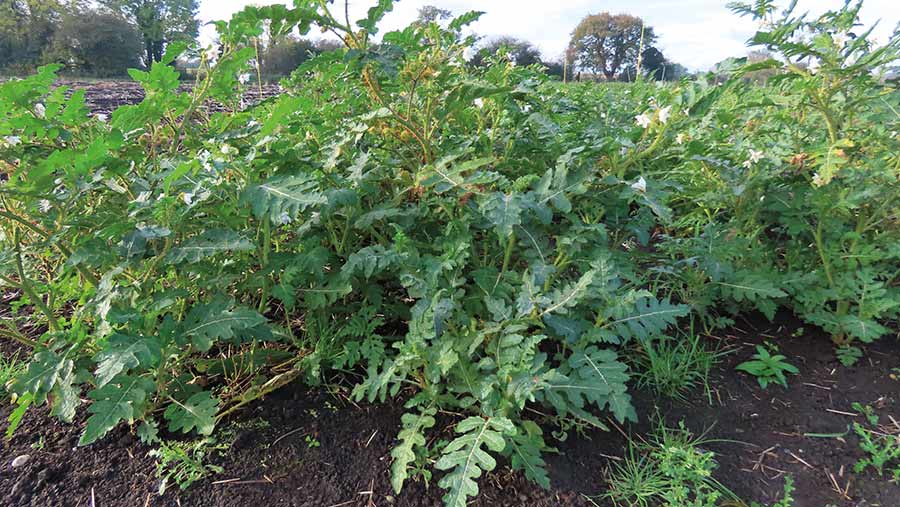
This leaves a window of opportunity for weeds to take hold, and with no herbicides available, this can be even more challenging. Planting the crops in rows to allow the use of an inter-row hoe could be one way around this issue, he suggests.
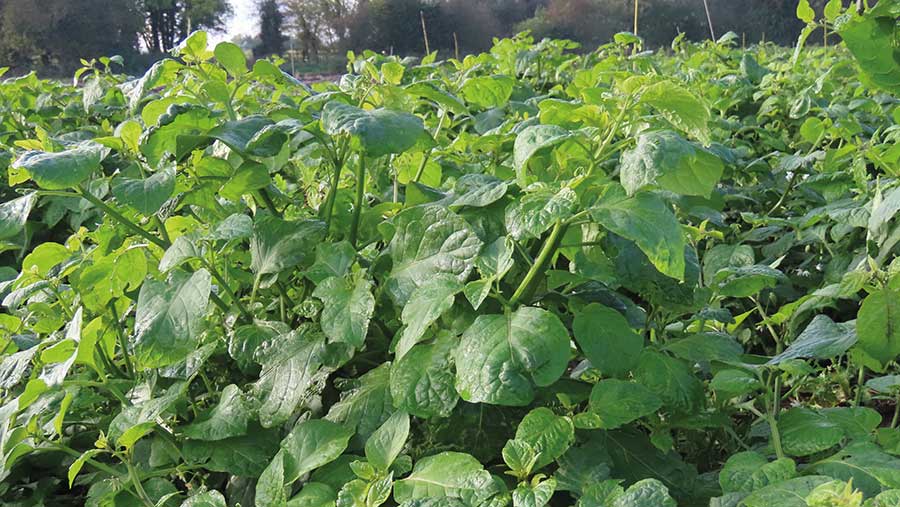
Establishment
As these species are not native to the UK, establishment can be a challenge. The optimum sowing date is mid-May to mid-June, but this conflicts with cash crop growing periods, Dr Grove notes. Conventional farm machinery was used in planting between two cash crops in field-scale plots 10m long and 4m wide. Shallow planting at a depth of 1cm or less is required.
A seed rate of 20kg/ha, encompassing a lentils seed filler, to bulk out the very fine Solanum seeds, was used. In general, a 75kg N/ha seed-bed nitrogen application is recommended. The latest viable trap crop sowing date for effective PCN control was found to be the end of June in north Shropshire, with end of July sowings causing poor establishment. Trap crops planted in Lancashire failed to establish, most likely due to a heavy rainfall after planting, which reduced soil temperature and germination.
Impact on nematode PCN populations
Further trials in north Shropshire in 2021 assessed the effect of trap crops on the reduction in PCN populations and the impact of seedbed N at 50kg N/ha or 100kg N/ha. The PCN reductions ranged from 37-40% for sisymbrifolium and 48-56% for scabrum.
“These reductions were considerably lower than previous trial work in Holland, as we would normally expect a 70-75% reduction. “However, we were working with exceptionally high egg counts, with some soils containing up to 248 eggs a gram – and less than optimum plant counts, so the trap crops were still having a significant impact,” he says. When compared with non-planted fallow plots, PCN populations declined on average by 26%, but this ranged from zero to 30%. This is because nematode numbers naturally decline in the absence of a host.
Nitrogen trial
As trap crops are often slow to establish, the effect of seed-bed nitrogen on trap crop establishment and growth was assessed. Results indicated higher trap crop ground cover and establishment from the higher rate, with scabrum more responsive to nutrition. Dr Grove suspects this is because scabrum is a leafier species than sisymbrifolium and therefore responds better to nitrogen.
However, there was no statistical difference between PCN results, so further experiments are required. “This was the first time trap crops were trialled alongside the use of seed-bed fertiliser, so it is still early days to recommend growers apply the extra dose, with just one years’ worth of data, particularly with the high fertiliser price,” he says.
Root structure
Looking at roots, biomass measurements at 122 days after planting showed scabrum to have a substantially greater proliferation of fine roots, with greater fresh weight. “This may help explain its greater influence on PCN numbers and response to nitrogen. Greater numbers of finer roots are likely to release more root exudates and should reduce PCN populations further.”
Next steps
Dr Grove hopes that trap crops will be included in the Environmental Land Management scheme, allowing farmers to get the most from biological control methods. Further trial work is set to take place if an Innovate UK funding application is successful, which hopes to refine establishment and nutrition management. “If growers want to get the full potential out of trap crops, then we need the next level of detail to achieve this. There is also potential to set up breeding programmes to develop more location-specific trap crop species,” he concludes.
All about potato cyst nematodes
The potato cyst nematode (PCN) is a challenging pest for potato growers to control, infecting almost half of the UK’s potato land, with estimated annual yield losses costing the sector as much as £26m. The pests remain in cysts in soils for more than 20 years. Potato planting stimulates the nematodes to hatch from the cysts, which can contain between 200 and 500 juveniles each. There are two main species of PCN, Globodera rostochiensis and Globodera pallida.
The first is less problematic as many UK potato varieties have significant resistance, while pallida is the main cause of concern due to limited varietal resistance causing widespread issues. For example, Maris Piper, one of the UK’s most widely used potato varieties, is fully resistant to rostochiensis, but is completely susceptible to pallida. Thanks to Harper Adams University’s nematology lab, the PCN population in this trial was identified as Globodera pallida as the sole species, demonstrating the effectiveness of the trap crop against them.
What is Innovative Farmers?
Innovative Farmers is a not-for-profit membership network launched in 2015, for farmers and growers who want to run on-farm trials. Through the network, groups of farmers can work directly with a researcher to design practical on-farm trials, called Field Labs. Innovative Farmers is part of the Duchy Future Farming Programme, funded by the Prince of Wales’ Charitable Foundation. The network is backed by a team from Innovation for Agriculture, Linking Environment and Farming (Leaf), the Organic Research Centre and the Soil Association.
